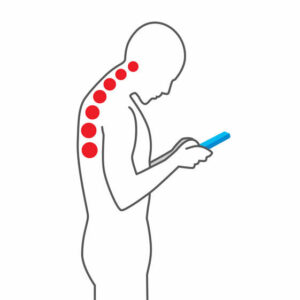

If you are like me, you spend a significant portion of your day looking at screens—whether it’s your phone, computer, or tablet.
The convenience of technology has undeniably transformed our daily routines, but it has also brought a new set of physical challenges.
One of the most common is “tech neck,” a term used to describe the forward head posture we adopt while looking down at our devices.
Over time, this posture can lead to a range of physical issues, including muscle pain, tension, and, as I’ve experienced firsthand, increased anxiety and stress.
Tech neck may seem like a minor inconvenience at first, but its impact can extend beyond the physical, seeping into your mental health.
In this article, we will explore how tech neck posture causes anxiety and tension, focusing on both the physiological and psychological connections.
Drawing from scientific studies and personal experience, we shall examine how this modern-day posture problem contributes to stress, neck tension, and overall discomfort.
“How Tech Neck Posture Causes Anxiety and Tension
- What Is Tech Neck Posture?
- The Link Between Tech Neck and Physical Stress
- How Tech Neck Posture Leads to Anxiety
- The Vicious Cycle of Stress and Neck Tension
- The Role of Neck and Shoulder Pain in Increasing Mental Strain
- Real-Life Examples: How Tech Neck Affects Daily Life
- Conclusion: How Tech Neck Posture Causes Anxiety and Tension
What Is Tech Neck Posture?
Tech neck refers to the forward, downward posture we adopt while using digital devices, particularly smartphones and laptops.
The head, typically weighing about 10 to 12 pounds, exerts additional force on the neck muscles when tilted forward. The further you tilt, the more strain it puts on your neck and upper back muscles.
This forward posture often leads to discomfort, pain, and tension in the neck and shoulders, but it doesn’t stop there.
This posture is far more than just a physical nuisance. The way we hold ourselves can directly affect our mental state, and tech neck, in particular, has been linked to heightened anxiety and stress levels.
When we slouch or crane our necks forward, our body sends subtle signals to the brain, which can influence mood and emotional well-being.
The Link Between Tech Neck and Physical Stress
One of the first things I noticed when I began experiencing tech neck was the tension in my shoulders and neck.
After long hours of working at my desk or scrolling through my phone, I would feel tightness creeping up from my shoulders, all the way to my neck. It turns out this is a common experience—one that is directly linked to how we position ourselves while using technology.
When your head tilts forward, it forces the muscles in the back of your neck and shoulders to work harder to keep your head balanced.
This leads to muscle fatigue, tension, and pain, which can compound over time. Tension shoulders and neck are often the first signs that something is wrong, signaling the beginning stages of tech neck.
But physical tension is not the only problem.
According to a study published in the Journal of Physical Therapy Science, the physical discomfort caused by tech neck can activate the body’s stress response, increasing levels of cortisol, the stress hormone.
This means that the stress and neck tension aren’t just linked to pain, but also to a physiological stress response.
How Tech Neck Posture Leads to Anxiety
It might seem strange to think that something as simple as a forward neck posture can lead to anxiety, but the connection is real.
When your body is in a state of physical discomfort, it triggers a stress response that can spiral into mental strain.
The neck ache from stress is not just a symptom of physical strain but can also exacerbate feelings of anxiety.
One key reason for this is the connection between posture and the nervous system. Poor posture, such as tech neck, compresses the nerves running from the neck to the rest of the body.
This can interfere with normal breathing patterns and reduce oxygen flow, which, over time, leads to shallow breathing.
Shallow breathing is a well-known trigger for anxiety, as it sends signals to your brain that something is wrong, increasing your overall feeling of unease.
I experienced this firsthand during a particularly stressful week.
After long hours of hunching over my computer, not only did I have a sore neck from stress, but I also noticed that my heart rate was higher than usual, and my anxiety was more pronounced.
I had not changed anything in my routine, except for the amount of time I spent sitting at my desk, hunched over my laptop.
The Vicious Cycle of Stress and Neck Tension
Once tech neck has taken hold, it can lead to a vicious cycle of stress and neck pain.
As tension builds in the neck muscles, the discomfort can cause mental stress, making it harder to relax.
And as stress increases, the body responds by tensing up even more, which only worsens the physical pain.
This feedback loop is something I have experienced personally.
After spending an entire day at my desk without proper posture, my neck hurting from stress became so uncomfortable that I found it difficult to focus on anything else.
The pain in my cervical neck was constant, and as it intensified, so did my feelings of stress and anxiety. It felt like my body was on high alert, and even small tasks felt overwhelming.
This cycle is something that affects many people who experience tech neck.
Studies show that chronic neck and shoulder pain, often caused by poor posture, is closely linked to increased stress and anxiety levels.
The constant physical discomfort signals the brain to remain in a heightened state of alert, which makes it difficult to unwind.
The Role of Neck and Shoulder Pain in Increasing Mental Strain
The physical effects of tech neck aren’t just limited to the neck itself.
Neck and shoulder pain from stress can spread to other areas of the body, particularly the upper back and shoulders.
Over time, this constant tension can lead to chronic pain conditions that make day-to-day life more difficult.
In my case, the tension in my neck gradually spread to my shoulders, making it hard to find a comfortable position whether sitting, standing, or lying down.
But it is not just the physical pain that takes a toll. The emotional and mental strain of dealing with chronic pain can amplify feelings of anxiety and depression.
When your body is constantly sending pain signals, it affects your ability to focus, enjoy proper sleep, and relax, all of which are critical for maintaining good mental health.
It is no wonder that people who suffer from tech neck often report higher levels of anxiety, as the discomfort takes a toll on both body and mind.
A study published in The Clinical Journal of Pain found that chronic neck pain is associated with greater levels of mental distress, including anxiety and depression.
The ongoing pain leads to a reduced quality of life, affecting everything from social interactions to sleep quality.
Real-Life Examples: How Tech Neck Affects Daily Life
In my own life, tech neck became most apparent when I started working from home.
Without the structured office environment, I found myself spending more time hunched over my laptop in California in less-than-ideal positions.
Over time, this poor posture led to persistent neck and shoulder pain from stress, which made it harder to concentrate on my work.
I was not alone in this experience. A friend of mine, who also works remotely, reported similar issues.
He noticed that after long Zoom meetings, he would feel tightness in his shoulders and a neck ache from stress that lingered long after he closed his laptop.
The physical discomfort was enough to make him feel irritable and anxious, especially when the pain interrupted his sleep.
Another example comes from a family member who spends hours on her phone each day.
After several months of scrolling social media and texting, she began to develop neck hurting from stress that made even short periods of phone use uncomfortable.
The persistent tension in her neck led to increased anxiety, as the pain became a constant reminder of her discomfort.
Conclusion: How Tech Neck Posture Causes Anxiety and Tension
In conclusion, fixing tech neck posture is very important. While it does not just cause physical pain—it also triggers mental stress, leading to increased anxiety and tension.
The link between poor posture, physical discomfort, and mental strain is clear: when the body is in a state of chronic tension, the mind follows.
Tech neck places undue stress on the neck and shoulders, leading to pain that can exacerbate feelings of anxiety and unease.
As I have learned from my own experience, this feedback loop of stress and neck tension is hard to break once it starts.
The more you strain your neck by hunching over your devices, the more likely you are to experience pain, and as the pain increases, so does your mental stress.
While tech neck is a common issue in our screen-filled world, being mindful of posture and taking steps to relieve tension can make a world of difference in both physical and mental well-being.
References:

